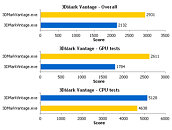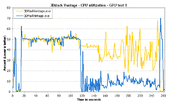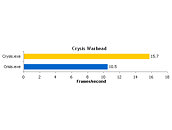Tuesday, October 13th 2009

Intel IGPs Use Murky Optimisations for 3DMark Vantage
Apart from being the industry's leading 3D graphics benchmark application, 3DMark has had a long history of 3D graphics hardware manufacturers cheating with their hardware using application-specific optimisations against Futuremark's guidelines to boost 3DMark scores. Often, this is done by drivers detecting the 3DMark executable, and downgrading image quality, so the graphics processor has to handle lesser amount of processing load from the application, and end up with a higher performance score. Time and again, similar application-specific optimisations have tarnished 3DMark's credibility as an industry-wide benchmark.
This time around, it's neither of the two graphics giants in the news for the wrong reasons, it's Intel. Although the company has a wide consumer base of integrated graphics, perhaps the discerning media user / very-casual gamer finds it best to opt for integrated graphics (IGP) solutions from NVIDIA or AMD. Such choices rely upon reviews evaluating the IGPs performance at accelerating video (where it's common knowledge that Intel's IGPs rely heavily on the CPU for smooth video playback, while competing IGPs fare better at hardware-acceleration), synthetic and real-world 3D benchmarks, among other application-specific tests.
Here's a shady trick Intel is using to up its 3DMark Vantage score: the drivers, upon seeing the 3DMark Vantage executable, change the way they normally function, ask the CPU to pitch in with its processing power, and gain significant performance according to an investigation by Tech Report. While the image quality of the application isn't affected, the load on the IGP is effectively reduced, deviating from the driver's usual working model. This is in violation of Futuremark's 3DMark Vantage Driver Approval Policy (read here), which says:
Source:
The Tech Report
This time around, it's neither of the two graphics giants in the news for the wrong reasons, it's Intel. Although the company has a wide consumer base of integrated graphics, perhaps the discerning media user / very-casual gamer finds it best to opt for integrated graphics (IGP) solutions from NVIDIA or AMD. Such choices rely upon reviews evaluating the IGPs performance at accelerating video (where it's common knowledge that Intel's IGPs rely heavily on the CPU for smooth video playback, while competing IGPs fare better at hardware-acceleration), synthetic and real-world 3D benchmarks, among other application-specific tests.
Here's a shady trick Intel is using to up its 3DMark Vantage score: the drivers, upon seeing the 3DMark Vantage executable, change the way they normally function, ask the CPU to pitch in with its processing power, and gain significant performance according to an investigation by Tech Report. While the image quality of the application isn't affected, the load on the IGP is effectively reduced, deviating from the driver's usual working model. This is in violation of Futuremark's 3DMark Vantage Driver Approval Policy (read here), which says:
With the exception of configuring the correct rendering mode on multi-GPU systems, it is prohibited for the driver to detect the launch of 3DMark Vantage executable and to alter, replace or override any quality parameters or parts of the benchmark workload based on the detection. Optimizations in the driver that utilize empirical data of 3DMark Vantage workloads are prohibited.There's scope for ambiguity there. To prove that Intel's drivers indeed don't play fair at 3DMark Vantage, Tech Report put an Intel G41 Express chipset based motherboard with Intel's latest 15.15.4.1872 Graphics Media Accelerator drivers, through 3DMark Vantage 1.0.1. The reviewer simply renamed the 3DMark executable, in this case from "3DMarkVantage.exe" to "3DMarkVintage.exe", and there you are: a substantial performance difference.A perfmon (performance monitor) log of the benchmark as it progressed, shows stark irregularities in the CPU load graphs between the two, during the GPU tests, although the two remained largely the same during the CPU tests. An example of one such graphs is below:When asked for a comment to these findings, Intel replied by saying that its drivers are designed to utilize the CPU for some parts of the 3D rendering such as geometry rendering, when pixel and vertex processing saturates the IGP. Call of Juarez, Crysis, Lost Planet: Extreme Conditions, and Company of Heroes, are among other applications that the driver sees and quickly morphs the way the entire graphics subsystem works. A similar test run on Crysis Warhead yields a similar result:Currently, Intel's 15.15.4.1872 drivers for Windows 7 aren't in Futuremark's list of approved drivers, none of Intel's Windows 7 drivers do. For a complete set of graphs, refer to the source article.



45 Comments on Intel IGPs Use Murky Optimisations for 3DMark Vantage
Now, on the other hand, if it does indeed lower the quality of the final product, and this wasn't stated anywhere, then by all means they should get sued.
The thing that really bugs me here, is how deppressingly and catastrophically bad intel's igps are in reality.
I'm... almost willing to let them have that, solely out of pity.
If it helps the shitty performance of Intel's IGPs, I say let them do it, but they should remove the optimization from the Furturemark exes, just to adhere to the rules.Maybe I missed something in the article, where does it say that it is downgrading the image to get a better score?
And for heaven's sake, they use the EXE filename to detect when to make their IGP look better... a half-decent first-year university student wouldn't use such a simplistic approach...
It just happens to be against Futuremark rules. Though logically, I have to wonder how much that rule makes sense. I mean, they are allowed to do it in real games, and 3DMark is supposed to be a benchmark to measure game performance....so why can't they apply the same optimizations to 3DMark as they do to real games?
And we all know the various cards perform different for various games. So the argument that you bought something because you thought it performed better based on one benchmark doesn't work. Just an example of the flaws in your logic: What if I went and bought a HD4890 because it outscores a GTX260 216 in 3Dmark06...but if I went and fired up Far Cry, the GTX260 performs better... It is all about optimizations these days, and no one should be buying a card based on 3DMark scores...to do so is silly.
Now, if they applied this optimization to just 3DMark, I would say it is wrong, however it has been applied to most games as well. So, IMO, it isn't really that wrong.